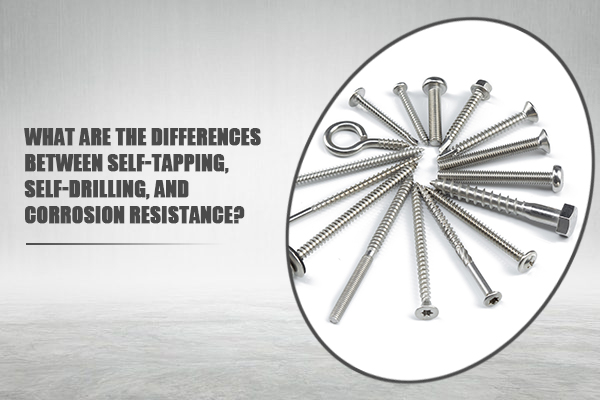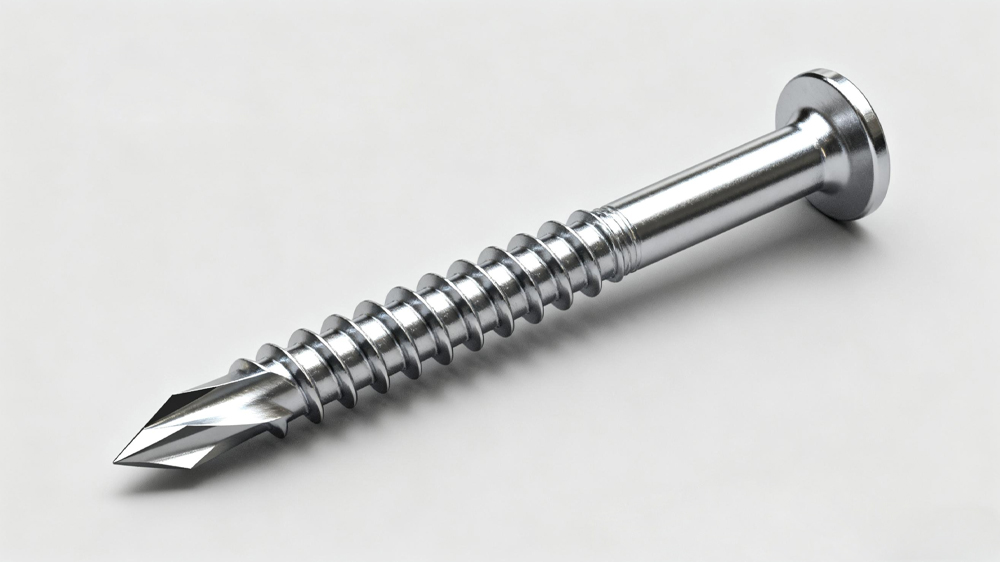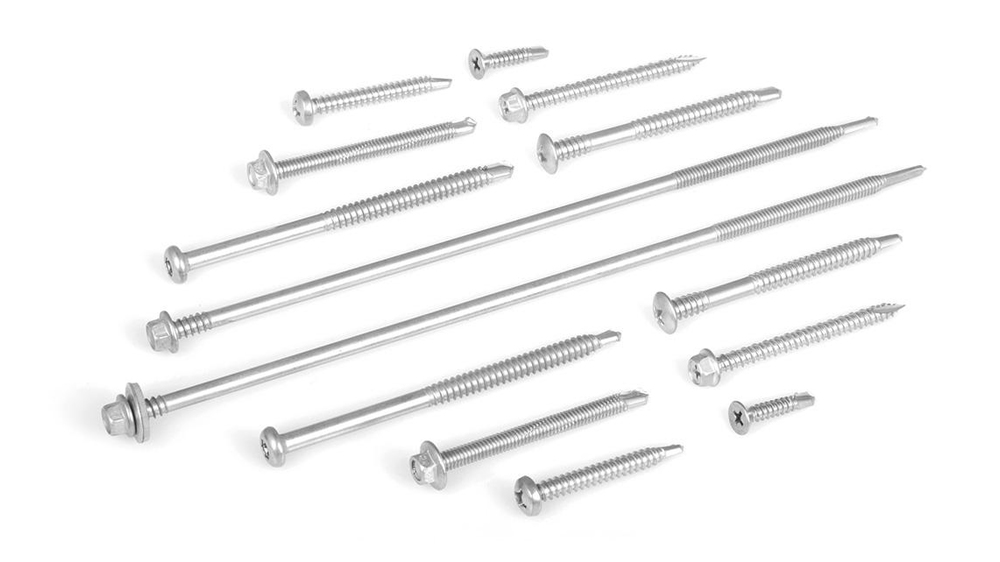VIDEO & CENTER

- Self-tapping Screws: The Foundation Choice for Efficient Fastening
Self-tapping screws are the most fundamental and widely used members of the drill bit screw family. Their core feature lies in the self-tapping thread design, which enables them to cut the matching threads on specific materials (such as thin metal sheets, plastics, wood, and composite materials) without the need for pre-drilling, achieving self-tightening.

Core advantages:
- Installation ease: No need for pre-drilling or tapping, significantly reducing installation time and enhancing fastening efficiency. Especially suitable for thin plate connections and rapid assembly scenarios.
- Cost-effectiveness: The structure is relatively simple, resulting in lower manufacturing costs, making it the preferred choice for cost-effective fastening solutions.
- Wide applicability: Exhibits excellent fastening performance for various non-metallic and relatively soft metal materials (such as aluminum, thin steel plates).
Key identification points:
- Thread shape: Usually has a sharper thread profile, which is conducive to cutting the material. Common types include coarse-threaded self-tapping screws (such as ST threads) and fine-threaded self-tapping screws (such as AB, B threads), which correspond to different materials and connection strength requirements respectively.
- Tail design: The standard self-tapping screws usually have a pointed tail or a flat tail (without drilling function), and they need to be directly screwed into the material through their threads.
Application scenarios and selection points:
- Ideal application: Lap joints for thin metal plates (0.8mm - 6mm), fixation of plastic parts, connection of wooden structures, assembly of air conditioning shells, fixation of electrical enclosures, etc.
- Selection key points: Strictly match the thickness and hardness of the fastened materials. Materials that are too thin or too soft are prone to slippage; materials that are too hard may cause thread cracking or installation difficulties. It is essential to select the matching self-drilling screw specifications (diameter, length, pitch) and head types (flat head, countersunk head, hexagonal flange head, etc.) to meet specific fastening requirements.
Installation Tips: It is recommended to use low-speed power tools or manual screwdrivers, applying appropriate axial pressure to ensure the threads are smoothly engaged. Avoid high-speed rotation that may cause overheating or damage to the threads.
- Self-drilling Screws: A One-Step Solution for Drilling and Tightening
Self-drilling screws are an evolved version of the drill-end screw technology. The revolutionary aspect lies in integrating the drilling and tapping functions into one, providing a one-step installation experience.

Core advantages:
- Ultimate efficiency: No need for pre-drilling. The drill bit tail end can directly penetrate the steel plate (with a thickness of up to 12mm or even higher), and at the same time complete tapping and tightening. This greatly simplifies the installation process of the steel structure, especially suitable for high-altitude operations or the fixation of large components.
- Strong connection: Since the drilling process is completed by the screw itself, the hole and the thread are perfectly matched, forming a high-precision and high-strength mechanical lock. It has excellent shear resistance and pull-out resistance performance.
- Precise positioning: The self-drilling process ensures the accuracy of the screw position, reducing the error in alignment.
Key identification points:
- Tail drill bit: The most distinctive feature is that the end has a cutting edge similar to a twist drill, and the material is usually high-hardness alloy steel (such as 42CrMo), with excellent drilling capabilities. The diameter and shape of the drill bit (such as three-pointed or four-pointed) determine the thickness of the material that can be drilled and the drilling efficiency.
- Thread structure: After drilling, the subsequent threaded part is responsible for tapping and fastening, and it is usually designed as self-tapping threads or mechanical threads.
Application scenarios and selection points:
- Core field: Steel structure buildings (beam supports, color steel plates, sandwich panels fixation), heavy equipment installation, bridge engineering, ship manufacturing, large ventilation ducts, etc. where high-strength fastening is required through thick steel plates.
- Selection key points: The drill bit capacity must be greater than the thickness of the steel plate! This is the primary principle for selection. Clearly identify the type of the material to be drilled (carbon steel, stainless steel) and the actual thickness, and select the corresponding drill bit diameter and drilling capacity of self-drilling screws (such as Φ5.5x25mm indicates a drill bit diameter of 5.5mm, applicable thickness ≤ 6mm, total length 25mm). At the same time, consider the head driving method (internal hexagon, external hexagon, cross) and anti-corrosion coating.
Installatio: Must use electric tools with high torque and high speed (such as impact drills, electric hammer drill heads mode). During installation, keep the tool and the screw perpendicular, apply stable pressure, and ensure that the drill bit fully bites into the material. Pay attention to observe the moment of drill penetration, stop immediately to avoid over-tightening which may cause thread wear or head fracture.
- Corrosion-resistant Screws: The Lasting Guardians in Harsh Environments
In environments such as dampness, acid and alkali, salt fog, etc., the rusting problem of ordinary carbon steel screws will rapidly lead to the failure of fastening, causing serious safety hazards and high maintenance costs. Corrosion-resistant drill tail screws have emerged to address this issue. Their core value lies in providing long-term anti-corrosion protection.
Main types and characteristics of corrosion-resistant screws:
Stainless steel drill tail screws:
- Material advantages: The base material itself has excellent corrosion resistance. Commonly used austenitic stainless steel (such as 304, A2) is suitable for general atmospheric and freshwater environments; super austenitic (such as 316, A4) or duplex stainless steel can resist strong acids, strong alkalis, and marine salt fog corrosion.
- Applications: Chemical equipment, marine engineering, coastal buildings, food machinery, bathroom fixtures, outdoor facilities, etc., where high anti-corrosion requirements are present.
- Notes: The strength is usually lower than that of the same specification alloy steel screws, and the price is higher. The selection must take into account the anti-corrosion grade and mechanical strength.

Galvanized Stud Screws:
- Process Principle: A zinc layer is applied to the surface of the carbon steel substrate through hot-dip (HDG) or electroplating (EG) processes, utilizing the sacrificial anode protection effect of zinc to delay the corrosion of the base material.
- Features: Extremely cost-effective, it is the most widely used anti-corrosion fastener. The hot-dip galvanized layer (typically ≥ 50 μm) has a salt spray resistance (NSS) time of up to several hundred hours and is suitable for general industrial environments and outdoors; electroplated galvanized (EG) has a thin layer and a good appearance, but relatively lower corrosion resistance.
- Applications: Medium-corrosion environments such as building steel structures, power towers, road guardrails, agricultural machinery, and standard factory buildings.
Dacromet/Geomet Stud Screws:
- Process Advantages: Utilizing a chrome-free zinc-aluminum coating technology, the coating consists of ultra-fine zinc flakes, aluminum flakes, and a special adhesive. It has extremely strong corrosion resistance (NSS up to over 1000 hours), excellent heat resistance (up to 300°C), no hydrogen embrittlement risk, and excellent environmental friendliness (no hexavalent chromium).
- Applications: Automotive chassis, engine peripheries, rail transit, high-end equipment, and fields with extremely high requirements for environmental protection and comprehensive performance.
Selection Core Elements:
- Environmental Corrosion Grade: This is the primary basis for selection. Based on the humidity, temperature, pH, and salt spray concentration of the usage environment (refer to ISO 12944 C2-C5 corrosion grades), select the corresponding anti-corrosion screw type and coating thickness.
- Material Matching: Ensure that the screw material does not have an electrochemical corrosion risk with the connected material (such as avoiding using un-insulated carbon steel screws directly on aluminum structures).
- Mechanical Performance Requirements: Anti-corrosion treatment may affect the screw strength (such as galvanizing may cause hydrogen embrittlement), so confirm whether the mechanical performance grade (such as 8.8 grade, 10.9 grade) meets the design load.
- Cost Consideration: Balance the initial procurement cost and the full life cycle maintenance cost while meeting the anti-corrosion life requirements.
Five, Drill Stud Screw Selection Guide: Scenario-based Decision-making and Engineering Practice
When faced with complex engineering requirements, how to quickly determine the optimal solution from self-tapping, self-drilling, and corrosion-resistant screws? The following practical selection framework helps you make precise decisions:
- Clearly define "the object to be fastened" and "installation conditions":
- Material type and thickness? (Thin sheet/ thick sheet/metal/non-metal?)
- Is drilling required? (Drilled already? Self-drilling required?)
- Installation space and tools? (Size of operation space? Available tool types?)
- Environmental corrosiveness? (Indoor dry? Outdoor humid? Chemical salt spray? High temperature?)
- Matching core functional requirements:
- Do you only need to quickly connect thin plates/soft materials? → Prioritize self-drilling screws (low cost, high efficiency).
- Do you need to penetrate thick steel plates (>3mm) and require high strength? → Must choose self-drilling screws (time-saving, labor-saving, reliable connection).
- Is there a risk of corrosion in the environment? → Must select corrosion-resistant screws (stainless steel/galvanized/dacromet), and choose specific types based on the corrosion level.
- Precise specification parameter determination:
- Diameter and length: Calculated based on the total thickness of the connecting piece and the required clamping force, ensuring that the effective thread length is sufficient.
- Head and drive: Selected according to the installation space, aesthetic requirements, and tool compatibility (flat head/counterbore head/square flange head; square/inner hexagon/outer hexagon).
- Thread specification: Choose coarse thread (for soft materials) or fine thread (for hard materials/thin plates).
- Strength grade: Select based on the design load (e.g., 4.8 grade, 8.8 grade, 10.9 grade).
- Corrosion resistance requirements: Clearly specify the required salt spray time or coating standard (such as HDG ≥ 85μm, Geomet 320).
- Key points of engineering practice:
- Pre-drilling (non-self-drilling scenarios): Even for self-tapping screws, pre-drilling a guiding hole (with a diameter approximately equal to the core diameter of the screw) in harder or thicker materials can significantly improve the installation smoothness and thread quality.
- Torque control: Use torque-adjustable tools to avoid breaking (over-tightening) or loosening (under-tightening) the screws. Refer to the recommended installation torque values provided by the manufacturer.
- Regular inspection and maintenance: Screws used in harsh environments should be included in the regular inspection plan. Check for any loosening, rusting, and replace the failed parts in a timely manner to ensure structural safety.
Choosing the right self-drilling screws is the foundation for ensuring the safety of a project
Self-tapping screws, self-drilling screws, and corrosion-resistant self-drilling screws - these three main types of self-drilling screws are not mutually exclusive but are specialized solutions designed to address different engineering challenges. Self-tapping screws excel in efficiency and economy, making them excellent assistants for thin material connections; self-drilling screws, with their one-step penetration and strong locking, become the efficiency champion for thick plates; and corrosion-resistant screws are dedicated to long-term protection, safeguarding structural safety in harsh environments.
In the practice of selecting fasteners, only by deeply understanding their core differences, accurately grasping the engineering scenarios (materials, thickness, corrosion, load), and strictly adhering to installation specifications, can the performance advantages of various self-drilling screws be maximized. Every correct selection is a solemn commitment to the quality of the project, construction efficiency, and long-term cost control. Let professional fastener knowledge become the most reliable tool in your engineering practice, and build a safety barrier for every connection.














